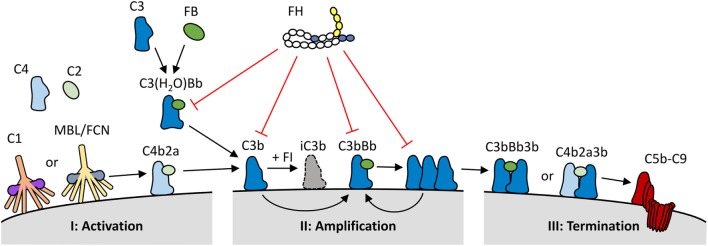Figure 1.
Overview of the role of factor H (FH) within the complement system. (I) The complement system is activated via binding of C1q (classical pathway), or mannan binding lectin/ficolins (MBL/FCN) (lectin pathway) in complex with serine proteases to specific molecules, or through the spontaneous activation of C3 into C3(H2O) (alternative pathway). Upon activation, the three pathways form C3 convertases (C4b2a or C3(H2O)Bb) resulting in the generation and deposition of C3b on the activating surface. (II) C3b forms new C3 convertase molecules (C3bBb) that enhance C3b deposition and amplify complement activation. (III) C3b can also bind to C3 convertases to generate C5 convertases (C4b2a3b or C3bBb3b); this process initiates the terminal pathway of complement activation, and the formation of the lytic C5b–C9 complex. FH keeps the spontaneous activation of C3 under control, and it also inhibits the complement system at both the activation and amplification stages. FH binds to deposited C3b and C3bBb complexes on human cell surfaces and inhibits further activation by three mechanisms: it competes with factor B (FB) for C3b binding and C3bBb generation; it increases the decay of C3bBb complexes, and it acts as a cofactor for factor I (FI), which in turn cleaves C3b into inactive C3b (iC3b).

